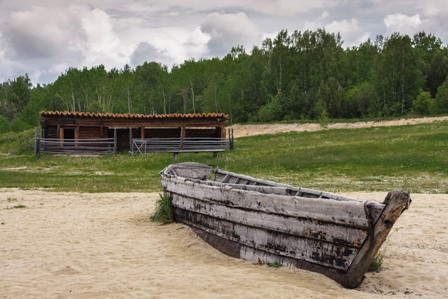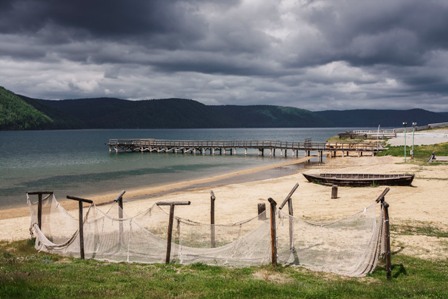БУРЯТСКИЙ МАЛОМОРСКИЙ РЫБОЛОВЕЦКИЙ СТАН
|
|
 |
Основу рыболовецкого стана составил рыбодел – двухкамерный амбар, вывезенный из с. Зама Ольхонского района. Амбар делился на две части: жилую и хозяйственную. В жилой части находились застеленные сеном нары, предназначавшиеся для сна рыбаков.
В хозяйственной части (под навесом) размещались наполовину закопанная в землю бочка с тузлуком – раствором поваренной соли для засолки, пресс для закатки крышек бочек с рыбой и сами бочки с готовой продукцией, паруса.
Основной промысловой рыбой на Байкале являлись омуль, хариус, сиг, осётр и сорная рыба: щука, сорога, язь, окунь, налим.
Солили рыбу сразу после лова. Участвовали в этом десять человек. Из них семь человек носили и чистили рыбу, один обмакивал её в соль, два – укладывали в бочку. Бочку после засолки закрывали через сутки. Засаливали по десять бочек в день, в каждой было по 800 омулей. В
Две трети рыбного улова продавали в свежем виде на острове Ольхон – на ярмарке с 15 июня по 15 июля, остальную часть – в солёном виде. Второй способ продажи рыбы проходил на рыбоделах, когда скупщики из бурят приезжали на тони и на месте скупали у артели рыбу. На большую часть полученных денег рыбаки закупали зерно в Верхоленском районе, а остальные деньги шли на хозяйственные нужды.
BURYATs` SMALL SEA FISHING site
LATE XIX-EARLY XX CENTURY.
At the end of the 19th — beginning of the 20th century, commercial fishing with nets became widespread on Lake Baikal. Fishing was the main source of income for professional fishermen, and a significant supplemental income for those practising fishing on the side. Up to 1,500 people have engaged in fishing annually on Lake Baikal.
The fishing was seasonal. The first fishing season took place at the beginning of May and lasted till July in the Maloe (small) Sea near the island of Olkhon. The second season from August to November took place on the Eastern shore of Lake Baikal. Fishing on Lake Baikal was free, however, there were also so-called "toni" – private patches of water on the lake owned by certain guilts of fishermen. “Tonies” were adjacent to the coastline, 2 km in length along the shore and 2-2. 5 km seaward. By the beginning of the twentieth century, there were 66 "tonis" on the Maloe (small) Sea.
Buryats set up fishing camps by the lake if their village was more than 20-50 km away. Central to the fishing camp was a barn for temporary housing and work. In the residential part, there were bunks with hay for fishermen to sleep. In the fishery part (the shed) there was a barrel half-buried in the ground with "brine" - diluted salt, a press for rolling up the lids of barrels with fish and fish barrels. The museum exposition presents a fishery relocated from the village of Zama in the Olkhon district in the Irkutsk Region.
In the fishing camp, there were also special "dryers" for seines and nets, areas designated for cooking, cutting and pickling fish, a tripod made of poles and a barrel with resin for tarring nets, "gates" for pulling long fishing nets to the shore. Boats were also stored here, sometimes under a canopy. The "fishing net boat" was designed to cast the net into the water; the "podezdok" boat was used to transport fish for sale. The rigging and other fishing gear was collectively owned by the members of the fishing project
and was shared among its members.
The primary species for fishing on Lake Baikal were omul, grayling, whitefish, sturgeon; they also caught river fish: pike, roach, ide, perch and burbot.
布里亚特人的渔业营地
十九世纪末到二十世纪初贝加尔湖旁边工业捕鱼变得很普遍。捕鱼占当地人口收入的很大一部分,对大型鱼类生产商而言,捕鱼是主要业务。每年1500人在贝加尔湖上钓鱼。
钓鱼是季节性的。第一个季节渔汛是从5月初到7月,在奥尔洪岛附近的小海。第二个从8月至11月在贝加尔湖东岸。在贝加尔湖上钓鱼是免费的,但在贝加尔湖上也存在“托尼”的水域,渔民占有这些水域。托尼靠海岸线,沿海岸长2公里,往海中长2–2.5公里。二十世纪初在小海上有66个托尼。
村庄离托尼的20-50公里的距离使布里亚特人建立钓鱼营地。钓鱼营的基础是一个木方由临时住房和工作的谷仓组成。住房有铺着干草的板床,供渔民入睡用的。公用部分(棚)中,有一个埋在地下的桶,桶里有盐水,压床,装有鱼的桶。博物馆展出从伊尔库茨克州奥利洪区的一个渔业营地。
渔业营地上用于干燥网鱼的干燥机,用于烹饪,切割和腌制鱼的地方,由杆子制成的三脚架和树脂桶。棚子下保存着船。 “围网”船的目的是将围网抛入水中撒网。这条船被用来运输鱼类以供出售。渔具归渔业劳动组合所有.
贝加尔湖上的主要商业鱼类是秋白鲑鱼,茴鱼 ,白鲑,鲟鱼,还会钓小鱼:狗鱼,拟鲤,圆腹鲦, 河鲈, 山鲇鱼。
Заявка успешно отправлена!
Укажите свои данные
мы ответим на ваш вопрос









